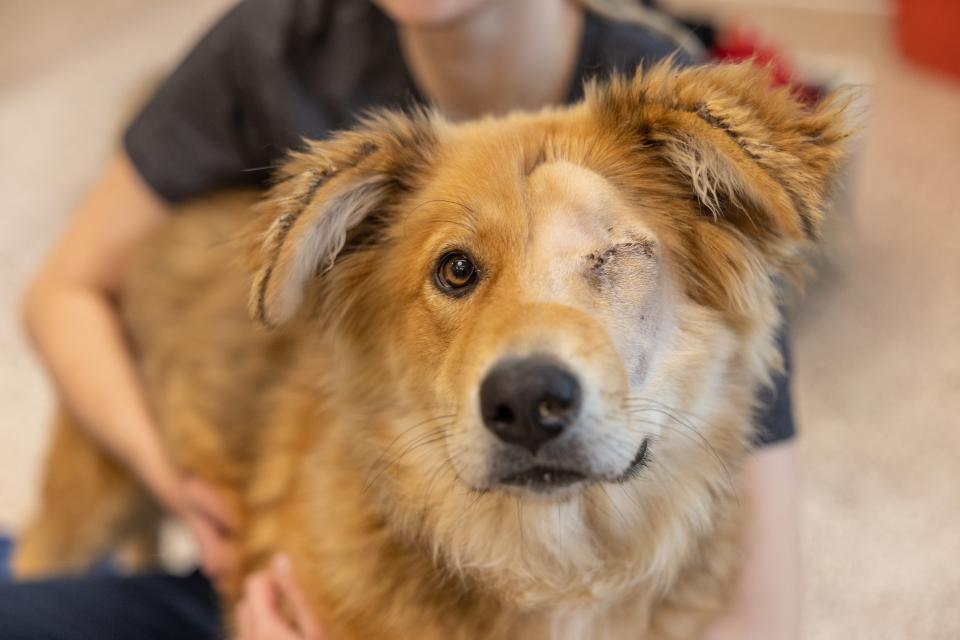There are many reasons why a pet may not be able to see. They may have been born without sight, or they may suffer from cataracts or glaucoma. Maybe they needed a special surgery called enucleation, or removal of one or both eyes, to relieve pain from an injury or infection.
Whatever the cause, pets without eyesight can have a good quality of life. You’ll just need to adapt how you care for them to keep your pet safe as they navigate the world using their other senses.
1. Establishing a routine and predictability are key
“All pets thrive on routine and predictability, but it’s even more important for animals that are blind,” says Dr. Kelly Gehlhaus, AHS’s Managing Clinic Veterinarian.
When your furry family member can’t see what’s around them, it’s important to keep furniture and important items, like food and water bowls, in the same place. Over time, your pet will memorize the layout of your home and avoid bumping into things.
If you’re introducing a new pet without eyesight to your home, try giving them a tour of their surroundings by laying down a trail of treats for them to follow as you show them around.
“Another tip is to lay down mats or rugs in front of their food, water, litter box, doors, or obstacles to provide a signal for them to pay attention,” recommends Dr. Kelly.
It’s also important to keep your home tidy so the areas where they roam are free of trip hazards.

2. Consider specialized training — for safety AND fun
Communicating frequently with your pet is important to alert them to where you are, where they are, when a door may be opening, or to navigate obstacles.
Specifically for dogs that are blind, teaching them special verbal cues for when they have to go down a step or move left or right can be particularly helpful while on walks outside.
Pets that can’t see still require plenty of enrichment and playtime. Training new tricks or skills using clicker training or verbal cues can get your pet’s mind working. You can also try scent-based games, like snuffle mats or feeder puzzles, and even a game of good ol’ tug with a rope or squeaky toy can provide daily fun.
For cats that are blind, try placing perches in front of open windows so they can feel and smell the breeze and hear birds or other wildlife.
Cat, by nature, are climbers and prefer to be off the ground,” says Dr. Kelly. “You can allow cats that are blind to climb, and they are generally pretty good at memorizing heights and distances.
Our experienced trainers and behavior specialists can teach you how to help your pet navigate and stay engaged without sight.
3. Keep your pet safe outdoors
The outdoors can pose all kinds of safety risks for animals that can’t see, like not being able to avoid traffic or various trip hazards. Never let your pet outside unless they’re leashed or in an enclosed area.
If you have a fenced in yard, fill any holes and remove sharp objects, and always supervise your dog while they’re in the yard. It can also be helpful to have a good recall so you can call them away from anything that may be dangerous. For cats, an enclosed catio is a great option for them to experience the outdoors safely.
If you’re out for a walk, always keep your pet on a leash to keep them away from dangers. And remember, routine is important, so try to walk the same route so your furry friend can memorize the path.
While we hope our furry family members never go missing, it’s important to be prepared. Update your pet’s microchip info to note that they’re blind and consider having a collar or tag made that alerts anyone who finds them that they can’t see.
4. Keep your pet safe indoors
If you have stairs in your home, it’s incredibly important to use baby gates or another method to block off stairs to avoid a potentially dangerous tumble.
Consider taping down or removing any cords that your pet may be able to access to avoid tripping and remove or cover anything sharp that they could potentially run into.


















